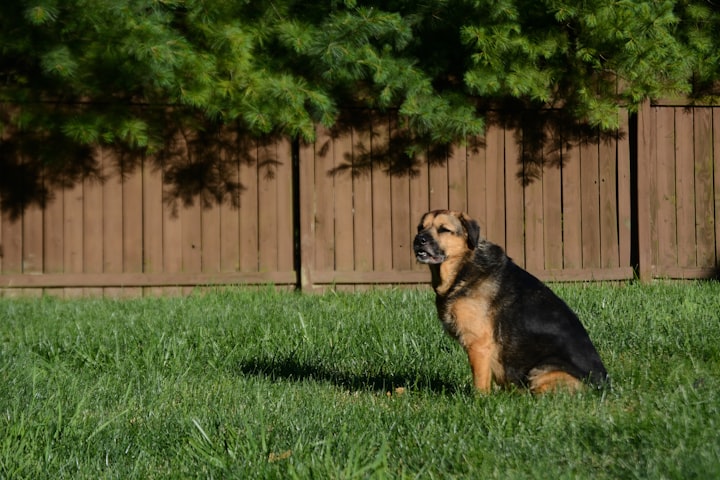Ensuring Your Outdoor Dog's Well-being: Essential Tips for a Happy and Safe Outdoor Life
Exploring Strategies to Foster the Health, Happiness, and Safety of Dogs Living Outdoors

Deciding whether to keep a dog outdoors requires careful consideration of the pros and cons associated with this lifestyle. While dogs are highly adaptable animals, it's crucial to provide a safe and enjoyable outdoor environment for them. In this article, we will explore the advantages and disadvantages of keeping a dog outdoors and provide ideas to ensure their safety and happiness.
Pros of Living Outside:
Natural Environment: Dogs are descendants of wolves and have an innate connection to nature. Living outside allows them to experience the sights, sounds, and smells of the outdoors, providing a stimulating environment that can enhance their overall well-being.
Physical Exercise: Dogs need regular physical activity to maintain a healthy weight and promote cardiovascular fitness. Living outdoors gives them more space to run, play, and explore, facilitating increased exercise opportunities compared to indoor-only dogs.
Mental Stimulation: The outdoor environment offers a wealth of mental stimulation for dogs. They can engage their senses by observing wildlife, tracking scents, and investigating new surroundings. This mental stimulation can help alleviate boredom and prevent behavioral issues that may arise from a lack of mental enrichment.
Reduced Behavioral Problems: Dogs living outside often have fewer behavior problems compared to their indoor counterparts. They are less likely to engage in destructive behaviors like chewing furniture or excessive barking since they have more freedom and outlets to release their energy and instincts.
Less Indoor Mess: Dogs can be messy, shedding hair and tracking dirt indoors. Keeping them outside can help minimize the amount of hair and dirt brought into the house, making it easier to maintain cleanliness within the home.
Cons of Living Outside:
Loneliness and Isolation: Dogs are social animals that thrive on human companionship. Keeping them outdoors for extended periods can lead to feelings of loneliness and isolation, potentially affecting their mental and emotional well-being. Regular interaction and quality time with their human family members are essential to mitigate this issue.
Extreme Weather Conditions: Outdoor dogs are exposed to various weather conditions, including heatwaves, cold snaps, rain, and storms. Extreme temperatures can pose health risks, such as heatstroke or hypothermia, if proper precautions are not taken. Adequate shelter and provisions for temperature regulation must be provided to protect them from harsh weather conditions.
Increased Risk of Predators: Depending on the geographic location, outdoor dogs may encounter wildlife or other animals that pose a threat. Predators, such as coyotes or large birds of prey, can harm or even kill a dog if they are not properly secured or supervised. It's crucial to implement measures to minimize these risks, such as secure fencing and supervised outdoor time.
Lack of Human Supervision: When living outdoors, dogs may not receive the same level of supervision and interaction from their human family members compared to indoor dogs. This can limit the opportunities for training, socialization, and addressing health issues promptly. Regular check-ups and training sessions become even more crucial to ensure their well-being.
Noise and Distractions: Living outdoors exposes dogs to various external stimuli, including loud noises, neighborhood activities, and other animals. These distractions can lead to anxiety or behavioral issues if not managed appropriately. Providing a secure and quiet area, away from excessive noise, can help alleviate stress and promote a sense of safety.
Ideas to Keep Your Outdoor Dog Safe and Happy:
Adequate Shelter: Provide a well-insulated, weatherproof dog house or shelter that offers protection from rain, wind, and extreme temperatures. Ensure it is large enough for the dog to stand, turn around, and lie down comfortably.
Secure Fencing: Install a sturdy fence around the designated outdoor area to prevent your dog from wandering off or encountering potential dangers. Regularly inspect the fence for any damage or gaps that may need repair.
Fresh Water and Food: Provide clean, fresh water and a balanced diet appropriate for your dog's breed, size, and activity level. Monitor food and water consumption to ensure they are adequately hydrated and nourished.
Regular Exercise and Playtime: Engage in daily exercise and play sessions with your dog to provide mental and physical stimulation. Take them for walks, provide interactive toys, and set up obstacle courses or play areas in the outdoor space.
Supervised Outdoor Time: While dogs may enjoy spending time outside, it's crucial to supervise their activities to ensure their safety and prevent them from getting into trouble. Regularly check on them and spend quality time together to strengthen your bond.
Social Interaction: Dogs need socialization with humans and other animals. Schedule regular visits to dog parks, enroll them in obedience classes, or arrange playdates with other friendly dogs to fulfill their social needs.
Regular Vet Care: Maintain a schedule of routine vet check-ups to monitor your dog's health and address any medical issues promptly. Ensure vaccinations, parasite prevention, and other necessary treatments are up to date.
Mental Stimulation: Provide interactive toys, puzzles, and activities that engage your dog's mind. Rotate toys regularly to keep their interest and prevent boredom.
Comfort and Safety Measures: During extreme weather conditions, provide additional comfort and safety measures such as cooling mats, heated beds, or protective clothing, depending on the climate.
Conclusion:
Deciding to keep a dog outdoors requires careful consideration of the pros and cons involved. While it can provide a natural and stimulating environment, it's essential to address the potential challenges and ensure your dog's safety and happiness. By providing adequate shelter, secure fencing, social interaction, regular exercise, and veterinary care, you can create a fulfilling outdoor environment that supports your dog's overall well-being. Remember, dogs thrive on love, attention, and companionship, so make sure to balance outdoor living with regular quality time indoors as well.
Learn more ways to care for your dog Click Here Now
About the Creator
Big Dog Shopping
Big Dog Shopping was created with the needs of big dog parents in mind. We understand the challenges of finding products that are suitable for larger breeds. We featuring only the highest quality products.





Comments
There are no comments for this story
Be the first to respond and start the conversation.